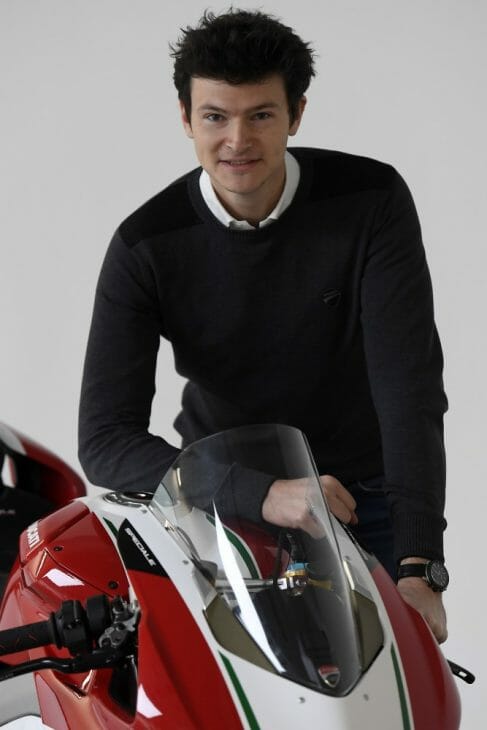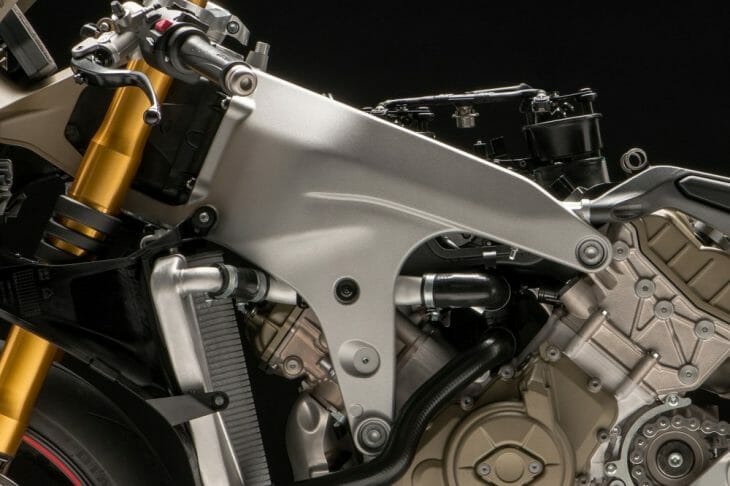Rennie Scaysbrook | December 4, 2017
The young Ducati designer chats about the aesthetics of the new Panigale V4
 Julien was the mastermind of the Scrambler and Supersport projects and has now been given the keys to the castle in the Panigale V4.
Julien was the mastermind of the Scrambler and Supersport projects and has now been given the keys to the castle in the Panigale V4.
Julien Clement is a young man who has been given a very important role. At just 29 years old, the French-born Senior Designer at Ducati Motor Holding has been tasked with penning the lines of the new Ducati Panigale V4—the first mass-produced V4 superbike by Ducati and the replacement for the redoubtable V-twin 1299 Panigale.
Clement’s already got some serious machines to put on his resume. He’s the creator of the Ducati Supersport that was released in 2016, but he’s more famous for creating the Scrambler—a project he started while still an intern at Ducati.
Now he’s been given the keys to the castle in the Panigale V4, and we caught up with him very briefly to hear his thoughts on the design of the most important Ducati sportbike in a generation.
 It was important to retain the Panigale shape, rather than try and all new design like the 999/1098 years.
It was important to retain the Panigale shape, rather than try and all new design like the 999/1098 years.
CN: Why has the silhouette of the V-twin Panigale been retained instead of creating an all-new design?
JC: “The project was to create the new Ducati Superbike but with a new V4 engine. So, we wanted a link to the previous generation to avoid any confusion because on the technical specification the step is big.
“This is not a road version of the MotoGP like the Desmoseidici RR was at the time but the technology is inspired by our racing prototype. And it would have been easier to go wrong with a completely new esthetic rather than evolving a design recognized as one of the best.”
 Controlling the heat coming from the V4 was important for ride quality on the street.
Controlling the heat coming from the V4 was important for ride quality on the street.
CN: What were the major challenges in adapting the design to the new V4 engine?
“During the development, it was sometimes difficult to appreciate the new volume (capacity) because of the V-twin bikes we are used to working on. So, the biggest challenge was to keep the bike compact, like the V-twin. But we managed it thanks to the relocation of the electronic package in front of the tank. We also designed it to reduce the amount of heat coming from the engine.”
 The lights are Julien’s proudest achievement on the V4.
The lights are Julien’s proudest achievement on the V4.
What part of the design are you most proud of?
“The lightning, I think. These are always the tricky parts because it is difficult to get an idea of the final illumination effect during the development.
“You need to explain your expectation with sketches and hope what is proposed to you by the suppliers will be what you have in mind. With the front light, we managed to hide the two high and low beams projectors as much as possible. And with the rear light, we manage to create a really flat case wrapped under the rear fairing. It gives an aerial aspect to the tail.
 Different as it is to the Panigale 1299, the Front Frame was not a major influence on the final design shape.
Different as it is to the Panigale 1299, the Front Frame was not a major influence on the final design shape.
The chassis is different in that Ducati has fitted the “Front Frame”. Did this influence the final look of the bike?
“Not really. We liked the fact we could play with this new aspect. We decided to integrate it to the fairing design and show this new concept.”
 Just like a diamond…
Just like a diamond…
Are there any parts of the design you would like to have incorporated but didn’t?
“Not as I remember. I am very happy with the design.”